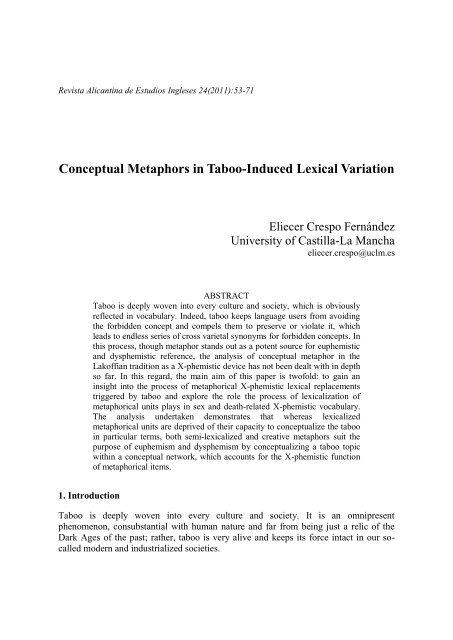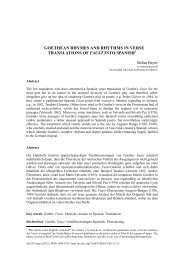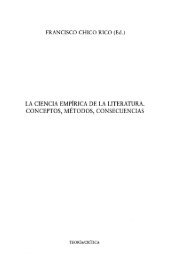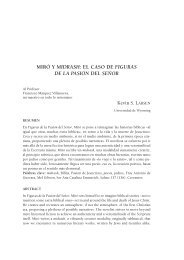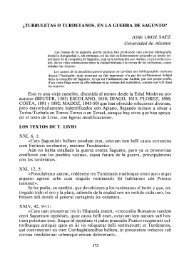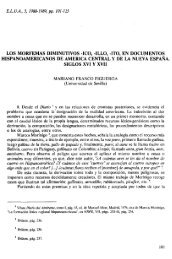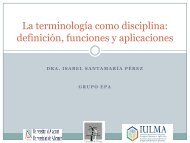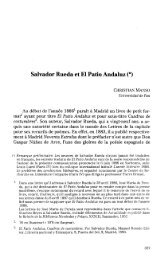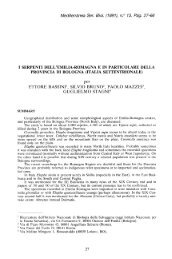Conceptual Metaphors in Taboo-Induced Lexical Variation
Conceptual Metaphors in Taboo-Induced Lexical Variation
Conceptual Metaphors in Taboo-Induced Lexical Variation
Create successful ePaper yourself
Turn your PDF publications into a flip-book with our unique Google optimized e-Paper software.
Revista Alicant<strong>in</strong>a de Estudios Ingleses 24(2011):53-71<br />
<strong>Conceptual</strong> <strong>Metaphors</strong> <strong>in</strong> <strong>Taboo</strong>-<strong>Induced</strong> <strong>Lexical</strong> <strong>Variation</strong><br />
1. Introduction<br />
Eliecer Crespo Fernández<br />
University of Castilla-La Mancha<br />
eliecer.crespo@uclm.es<br />
ABSTRACT<br />
<strong>Taboo</strong> is deeply woven <strong>in</strong>to every culture and society, which is obviously<br />
reflected <strong>in</strong> vocabulary. Indeed, taboo keeps language users from avoid<strong>in</strong>g<br />
the forbidden concept and compels them to preserve or violate it, which<br />
leads to endless series of cross varietal synonyms for forbidden concepts. In<br />
this process, though metaphor stands out as a potent source for euphemistic<br />
and dysphemistic reference, the analysis of conceptual metaphor <strong>in</strong> the<br />
Lakoffian tradition as a X-phemistic device has not been dealt with <strong>in</strong> depth<br />
so far. In this regard, the ma<strong>in</strong> aim of this paper is twofold: to ga<strong>in</strong> an<br />
<strong>in</strong>sight <strong>in</strong>to the process of metaphorical X-phemistic lexical replacements<br />
triggered by taboo and explore the role the process of lexicalization of<br />
metaphorical units plays <strong>in</strong> sex and death-related X-phemistic vocabulary.<br />
The analysis undertaken demonstrates that whereas lexicalized<br />
metaphorical units are deprived of their capacity to conceptualize the taboo<br />
<strong>in</strong> particular terms, both semi-lexicalized and creative metaphors suit the<br />
purpose of euphemism and dysphemism by conceptualiz<strong>in</strong>g a taboo topic<br />
with<strong>in</strong> a conceptual network, which accounts for the X-phemistic function<br />
of metaphorical items.<br />
<strong>Taboo</strong> is deeply woven <strong>in</strong>to every culture and society. It is an omnipresent<br />
phenomenon, consubstantial with human nature and far from be<strong>in</strong>g just a relic of the<br />
Dark Ages of the past; rather, taboo is very alive and keeps its force <strong>in</strong>tact <strong>in</strong> our socalled<br />
modern and <strong>in</strong>dustrialized societies.
54 Revista Alicant<strong>in</strong>a de Estudios Ingleses<br />
The power of taboo has its obvious reflection <strong>in</strong> vocabulary. Indeed, taboo keeps<br />
language users from avoid<strong>in</strong>g the forbidden concept and compels them to preserve or<br />
violate it, which leads to endless series of cross varietal synonyms for the verbalization<br />
of forbidden concepts. As Burridge (2004: 212) puts it, taboo “provides a fertile<br />
seedbed for words to flourish – and the more potent the taboo, the richer the growth”.<br />
This is part of the paradoxical nature of the taboo: we need to refer to the concepts<br />
themselves, no matter how much they are forbidden.<br />
In the reference to taboo subjects, language users resort respectively either to<br />
euphemism (i.e. the process thanks to which the taboo is stripped of its most explicit or<br />
obscene overtones) or to dysphemism (i.e. the process whereby the most pejorative traits<br />
of the taboo are highlighted with an offensive aim to the addressee or to the concept<br />
itself). From this viewpo<strong>in</strong>t, euphemism and dysphemism – X-phemism, 1 if we adopt the<br />
term<strong>in</strong>ology proposed by Allan and Burridge – are not merely a response to a forbidden<br />
subject; rather, these processes provide a way to speak about the taboo, that is, about the<br />
unspeakable, about those concepts banned from public doma<strong>in</strong>.<br />
Given that metaphorization stands out as one of the most prolific devices of lexical<br />
generation, it is hardly surpris<strong>in</strong>g that speakers turn to figurative language as a means of<br />
cop<strong>in</strong>g with taboo topics. Metaphor thus plays a crucial role <strong>in</strong> the way we manage<br />
forbidden concepts and manipulate the taboo referent, <strong>in</strong>sofar as it is at the user’s<br />
disposal to model the distasteful concept and present it without its pejorative overtones<br />
or, by contrast, with an <strong>in</strong>tensification of its most unacceptable conceptual traits. 2 In this<br />
regard, metaphor stands out as a major device <strong>in</strong> structur<strong>in</strong>g euphemism and<br />
dysphemism conceptually and therefore contributes to lexical variation 3 <strong>in</strong> the different<br />
taboo areas <strong>in</strong> a decisive way.<br />
The study of X-phemistic lexical variation along cognitive l<strong>in</strong>es is a topic that,<br />
curiously enough, has received relatively little attention <strong>in</strong> scholarly literature. In fact,<br />
apart from my own contributions to the subject <strong>in</strong> the taboo areas of sex (2008) and<br />
death (2006 and 2011), few studies have analysed conceptual metaphor <strong>in</strong> the Lakoffian<br />
tradition as a purely euphemistic or dysphemistic device (Bultnick 1998; Chamizo<br />
Domínguez 2000; Herrero Ruiz 2009: 252–260). In this regard, the ma<strong>in</strong> aim of this<br />
paper is twofold: to ga<strong>in</strong> an <strong>in</strong>sight <strong>in</strong>to the role conceptual metaphors play <strong>in</strong> the<br />
vocabulary triggered by taboo and analyse the process of lexicalization <strong>in</strong> sex and<br />
death-related figurative language. The choice for sex and death as taboo areas for the<br />
present paper is not at random. Though taboo subjects can vary widely, and they change<br />
along with our social attitudes and beliefs, the fact rema<strong>in</strong>s that sex and death have<br />
shown remarkable stay<strong>in</strong>g powers. In fact, both areas of <strong>in</strong>terdiction constitute such a<br />
fasc<strong>in</strong>at<strong>in</strong>g storehouse for metaphorical conceptualizations of attenuation and offense<br />
that Hughes (2000: 45) considers them “as universal areas of euphemism”.<br />
As euphemisms and dysphemisms are highly dependent on context, this study is not<br />
based on isolated words, but on coherent and contextualized discourses extracted,<br />
unless otherwise stated, from The British National Corpus (hereafter BNC), a 100<br />
million word collection of samples of written and spoken current British English. This<br />
contextualized study of lexical units derives from a usage-oriented onomasiological
<strong>Conceptual</strong> <strong>Metaphors</strong> <strong>in</strong> <strong>Taboo</strong>-<strong>Induced</strong> <strong>Lexical</strong> <strong>Variation</strong> 55<br />
approach, which, as Bald<strong>in</strong>ger (q. <strong>in</strong> Geeraerts 2009: 653) argues, focuses on the<br />
“designations of a particular concept”, that is, the actual lexical choices for a given (<strong>in</strong><br />
our case taboo) referent <strong>in</strong> a given situation.<br />
This paper is structured as follows. After briefly deal<strong>in</strong>g with the theoretical<br />
framework this study relies on and how figurative language manipulates taboo<br />
referents, I will analyse the role that the process of lexicalization plays <strong>in</strong> euphemistic<br />
and dysphemistic figurative language <strong>in</strong> the taboos area of sex and death. The<br />
conclusions and the f<strong>in</strong>al results obta<strong>in</strong>ed from the analysis will br<strong>in</strong>g this study to an<br />
end.<br />
2. Theoretical assumptions<br />
As already mentioned, the theoretical assumptions on which the present study relies are<br />
derived from the well-known cognitive model of <strong>Conceptual</strong> Metaphor Theory<br />
(hereafter CMT), <strong>in</strong>itially developed by Lakoff and Johnson <strong>in</strong> their sem<strong>in</strong>al work<br />
<strong>Metaphors</strong> We Live By (1980). Lakoff and Johnson revealed the centrality of metaphor<br />
to thought tak<strong>in</strong>g as examples metaphorical forms <strong>in</strong> everyday language. They claimed<br />
that we talk about th<strong>in</strong>gs the way we conceive them, and this is grounded <strong>in</strong> our<br />
experience and culture. From this standpo<strong>in</strong>t, metaphor is def<strong>in</strong>ed as “a cross-doma<strong>in</strong><br />
mapp<strong>in</strong>g <strong>in</strong> the conceptual system” (Lakoff, 1993: 203); that is, a mapp<strong>in</strong>g or set of<br />
conceptual correspondences from a source doma<strong>in</strong> (the realm of the physical or more<br />
concrete reality) to a target doma<strong>in</strong> (the more abstract entity, <strong>in</strong> our case, sex and deathrelated<br />
concepts). The source doma<strong>in</strong> is therefore used to understand, structure and,<br />
depend<strong>in</strong>g on the speaker’s <strong>in</strong>tention, mitigate or re<strong>in</strong>force the associations of a<br />
negative k<strong>in</strong>d of the target doma<strong>in</strong>.<br />
Therefore, with<strong>in</strong> the cognitive tradition, metaphor is understood as a device with<br />
the capacity to structure our conceptual system, provid<strong>in</strong>g, at the same time, a particular<br />
understand<strong>in</strong>g of the world and a way to make sense of our experience. Hence, the<br />
metaphor is, as Lakoff and Turner (1989: xi) claim, rather than a l<strong>in</strong>guistic expression<br />
or a figure of speech with an aesthetic value, a mode of thought and reason:<br />
Far from be<strong>in</strong>g merely a matter of words, metaphor is a matter of thought – all k<strong>in</strong>ds of<br />
thought: thought about emotion, about society, about human character, about language,<br />
and about the nature of life and death. It is <strong>in</strong>dispensable not only to our imag<strong>in</strong>ation, but<br />
also to our reason.<br />
Despite the close l<strong>in</strong>ks between metaphors and X-phemistic processes, cognitive issues<br />
have been largely excluded from the study of euphemism and dysphemism, which have<br />
been analysed from different l<strong>in</strong>guistic discipl<strong>in</strong>es such as lexical semantics,<br />
sociol<strong>in</strong>guistics, rhetoric and, more recently, pragmatics (cf. Casas Gómez, 2009: 725-<br />
739). As euphemism and dysphemism can be accurately and <strong>in</strong>sightfully described <strong>in</strong><br />
terms of cognitive abilities, Casas Gómez has def<strong>in</strong>ed X-phemistic processes with<strong>in</strong> the<br />
general framework of l<strong>in</strong>guistic <strong>in</strong>terdiction from a cognitive po<strong>in</strong>t of view. This scholar
56 Revista Alicant<strong>in</strong>a de Estudios Ingleses<br />
considers euphemism and dysphemisms as “[t]he cognitive process of conceptualization<br />
of a forbidden reality, which, manifested <strong>in</strong> discourse through the use of l<strong>in</strong>guistic<br />
mechanisms [....] enables the speaker, <strong>in</strong> a certa<strong>in</strong> “context” or <strong>in</strong> a specific pragmatic<br />
situation, to attenuate, or, on the contrary, to re<strong>in</strong>force a certa<strong>in</strong> forbidden concept or<br />
reality” (2009: 738).<br />
Follow<strong>in</strong>g Casas Gómez’s def<strong>in</strong>ition of euphemism and dysphemism, taboo<br />
language can be <strong>in</strong>sightfully studied accord<strong>in</strong>g to the conceptual networks <strong>in</strong> which Xphemistic<br />
metaphors are <strong>in</strong>cluded. Prior to mov<strong>in</strong>g to the analysis of X-phemistic<br />
metaphors types, I will move on now to the role conceptual metaphor plays <strong>in</strong> the<br />
manipulation of taboo topics.<br />
3. The X-phemistic metaphorical manipulation of taboo<br />
From the close connection between metaphor and the verbal mechanisms of mitigation<br />
and offence discussed <strong>in</strong> the previous sections, it seems evident that conceptual<br />
metaphor plays a crucial role <strong>in</strong> the way we manage taboo topics. In fact, metaphorical<br />
language is at the user’s disposal to model the taboo concept and present it without its<br />
most pejorative implications or, by contrast, <strong>in</strong>tensify<strong>in</strong>g those unacceptable conceptual<br />
traits with an offensive aim to the concept itself or to the audience.<br />
The euphemistic or dysphemistic functions that metaphors perform can be illustrated<br />
<strong>in</strong> the metaphorical disguise that a taboo such as ‘coition’ may adopt <strong>in</strong> public doma<strong>in</strong>.<br />
As part of the process of referent manipulation, this taboo would undergo a conceptual<br />
makeup <strong>in</strong> which the language user, depend<strong>in</strong>g on his or her <strong>in</strong>tention, may resort to a<br />
euphemistic metaphorical substitute like do the bus<strong>in</strong>ess or to a dysphemistic<br />
metaphorical word such as mount. Consider the follow<strong>in</strong>g examples:<br />
(1) I remember the first time we went to bed and 4 did the bus<strong>in</strong>ess. (BNC: CGC, 1671)<br />
(2) Her f<strong>in</strong>gers stroked my balls and her lips slid on my penis and <strong>in</strong> a few m<strong>in</strong>utes, free<br />
to call her what I wished, I pulled her down and mounted her. (BNC: ADA, 2206)<br />
The attenuat<strong>in</strong>g and offensive quality of the metaphorical realizations <strong>in</strong> these examples<br />
depend on the conceptual network to which they belong. Bus<strong>in</strong>ess with the mean<strong>in</strong>g of<br />
‘sexual <strong>in</strong>tercourse’ is motivated by the euphemistic metaphor TO COPULATE IS TO<br />
WORK, whereas mount is <strong>in</strong>cluded <strong>in</strong> a dysphemistic conceptualization which conceives<br />
sex <strong>in</strong> terms of horse-rid<strong>in</strong>g (cf. Crespo Fernández, 2008: 103-104). In this way,<br />
figurative language provides the speaker either with a l<strong>in</strong>guistic safeguard or a verbal<br />
weapon respectively for present<strong>in</strong>g the forbidden concept <strong>in</strong> communication and<br />
determ<strong>in</strong>es, by so do<strong>in</strong>g, the conceptual makeup of euphemism and dysphemism.<br />
Both euphemistic and dysphemistic realizations used to refer to a taboo concept are<br />
motivated by the characteristics of a given conceptual network. However, the semantic<br />
considerations of each of these processes of conceptual make-up greatly differ. In
<strong>Conceptual</strong> <strong>Metaphors</strong> <strong>in</strong> <strong>Taboo</strong>-<strong>Induced</strong> <strong>Lexical</strong> <strong>Variation</strong> 57<br />
euphemistic metaphorical substitution, the word or expression chosen to tone down the<br />
concept shares certa<strong>in</strong> conceptual traits with the l<strong>in</strong>guistic taboo, though it moves away<br />
from its literal mean<strong>in</strong>g with the purpose of reach<strong>in</strong>g the lexical neutralization of the<br />
taboo referent. Neutralization is thus a key concept <strong>in</strong> the analysis of the euphemistic<br />
process, s<strong>in</strong>ce it enables the adoption of new senses <strong>in</strong> lexical units by means of the<br />
temporal suspension of those conceptual traits considered <strong>in</strong>appropriate <strong>in</strong> social<br />
<strong>in</strong>teraction. And the conceptualization of the taboo plays a crucial role <strong>in</strong> this process of<br />
neutralization. Indeed, as Lakoff and Johnson (1980: 10) <strong>in</strong> the metaphorical structur<strong>in</strong>g<br />
of a given taboo concept the filter of metaphorical conceptualization through which a<br />
given topic is presented provides us with a partial understand<strong>in</strong>g of the concept,<br />
mask<strong>in</strong>g (i.e. euphemism) or reveal<strong>in</strong>g (i.e. dysphemism) particular aspects of the topic<br />
be<strong>in</strong>g dealt with. For <strong>in</strong>stance, the conceptualization A PROSTITUTE IS A WORKER, an<br />
extension of the above mentioned TO COPULATE IS TO WORK, is the source of<br />
metaphorical euphemistic labels like work<strong>in</strong>g girl ‘prostitute’ or commerce ‘sexual<br />
<strong>in</strong>tercourse’, <strong>in</strong> which the values related to the consideration of the sexual activity <strong>in</strong><br />
terms of a job are given priority, whereas the most explicitly related to sex are hidden;<br />
<strong>in</strong> this way, the euphemistic alternative is deprived of the heavily tabooed connotations<br />
of the concept.<br />
In the neutralization of the taboo which characteristically operates <strong>in</strong> this process of<br />
euphemistic manipulation, the metaphor generates an ambiguity which suggests that<br />
there may be a distasteful concept underneath. Therefore, the semantic uncerta<strong>in</strong>ty of<br />
metaphor moves to euphemism and stands out as one of its ma<strong>in</strong> features as a l<strong>in</strong>guistic<br />
phenomenon. As Burridge (2004: 224) puts it, “clearly, imprecision is what you want <strong>in</strong><br />
a euphemism and the most successful euphemistic substitutions always <strong>in</strong>volve very<br />
general expressions”. In this sense, for a euphemism to be effective, it must necessarily<br />
be more ambiguous than the taboo it aims at replac<strong>in</strong>g. On the contrary, the offensive<br />
capacity of dysphemistic metaphors does not depend on ambiguity; rather, <strong>in</strong> the<br />
dysphemistic manipulation of the taboo referent, as is the case of the metaphorical term<br />
mount <strong>in</strong> (2), the pejorative power is kept <strong>in</strong>tact because first, it is explicit with respect<br />
to its taboo referent; and second, because the conceptualization <strong>in</strong> which it is <strong>in</strong>cluded<br />
(TO COPULATE IS HORSE-RIDING) dehumanizes the act of coition and implicitly<br />
conceives sexual partners – women <strong>in</strong> the example proposed – as animals.<br />
The degree of lexicalization of the metaphorical item <strong>in</strong>cluded <strong>in</strong> a particular Xphemistic<br />
conceptualization gives way to different types of lexical substitutes for taboo<br />
concepts. In what follows, I will analyse the different metaphor and X-phemistic types<br />
to consider when deal<strong>in</strong>g with X-phemistic figurative language.<br />
4. The lexicalization of X-phemistic metaphors<br />
The euphemistic or dysphemistic quality of metaphorical items is greatly <strong>in</strong>fluenced by<br />
the degree of lexicalization of the l<strong>in</strong>guistic substitute, that is, the extent to which the<br />
tabooed conceptual traits have become associated with the X-phemistic metaphorical
58 Revista Alicant<strong>in</strong>a de Estudios Ingleses<br />
alternative. This process of lexicalization is not exclusive of taboo-<strong>in</strong>duced figurative<br />
language, though. Indeed, many non metaphorical terms which were once considered as<br />
euphemisms faded from euphemisms to ortophemisms and, with the pass<strong>in</strong>g of time,<br />
degenerated <strong>in</strong>to dysphemisms through contam<strong>in</strong>ation by the taboo topic. There are<br />
many examples of this process of euphemistic treadmill, a law of semantic change<br />
whereby “bad connotations drive out good” (Burridge, 2004: 213). This process is<br />
especially noteworthy <strong>in</strong> the so-called PC language, as po<strong>in</strong>ted out by Allan and<br />
Burridge (2006: 99-100). Take, for example, the word backward to refer to poor<br />
countries. Through contam<strong>in</strong>ation by the taboo connotations of mental illness, it<br />
degenerated <strong>in</strong>to a dysphemism <strong>in</strong> the late 1940s and had to be replaced by<br />
underdeveloped <strong>in</strong> the 1950s, a word free at that time from the negative associations of<br />
the taboo until the 1960s, when people needed a more positive word like emerg<strong>in</strong>g to<br />
refer to poor countries <strong>in</strong> a socially acceptable way. This adjective was <strong>in</strong> turn later<br />
replaced by a noun phrase like Third World and more recently by another label with a<br />
greater degree of ambiguity as the South (Ayto, 2007: 286-287).<br />
Similarly, the degree of lexicalization of the metaphorical alternative to the taboo<br />
referent leads to a multiplicity of X-phemistic alternatives, differ<strong>in</strong>g <strong>in</strong> their <strong>in</strong> their<br />
degree of ambiguity (and, therefore, <strong>in</strong> their euphemistic or dysphemistic capacity),<br />
which are generated by different types of metaphors. The classification proposed here is<br />
based on the one put forward by Chamizo Domínguez and Sánchez Benedito (2000).<br />
These scholars dist<strong>in</strong>guish three types of euphemisms and dysphemisms accord<strong>in</strong>g to<br />
their degree of lexicalization: lexicalized (those <strong>in</strong> which the figurative mean<strong>in</strong>g is<br />
regarded as the normal or literal mean<strong>in</strong>g); semi-lexicalized (the metaphorical substitute<br />
is associated with the taboo because of its <strong>in</strong>clusion <strong>in</strong> a conceptual doma<strong>in</strong> traditionally<br />
tied to the forbidden concept); and creative (the euphemistic or dysphemistic item is the<br />
result of a novel association with the taboo, only accessible <strong>in</strong> its phraseological<br />
context). It must be noted that as metaphors are so closely connected with euphemisms,<br />
Chamizo (1998: 47–70) had already applied this dist<strong>in</strong>ction to metaphorical language,<br />
dist<strong>in</strong>guish<strong>in</strong>g three types of metaphors: lexicalized or dead, semi-lexicalized and poetic<br />
or creative metaphors.<br />
The different metaphor types motivated by the process of lexicalization (lexicalized,<br />
semi-lexicalized and creative) give rise to their correspond<strong>in</strong>g X-phemistic<br />
metaphorical substitutes (explicit, conventional and novel), as graphically shown <strong>in</strong> the<br />
figure below <strong>in</strong> relation to the taboo topics ‘reach orgasm’ and ‘die’:
<strong>Conceptual</strong> <strong>Metaphors</strong> <strong>in</strong> <strong>Taboo</strong>-<strong>Induced</strong> <strong>Lexical</strong> <strong>Variation</strong> 59<br />
TABOO REFERENT<br />
‘reach orgasm’<br />
‘die’<br />
METAPHORICAL<br />
MANIPULATION<br />
<strong>Lexical</strong>ized Semi-lexicalized Creative metaphor<br />
metaphor metaphor<br />
Explicit Conventional Novel<br />
X-phemism X-phemism X-phemism<br />
come shoot arrive <strong>in</strong> Uganda<br />
pass away rest waltz<br />
Figure 1. Metaphor types and X-phemistic categories.<br />
The effect of metaphorical language on taboo topics such as ‘reach orgasm’ and ‘die’ is<br />
the source of three types of X-phemistic substitutes, lexicalized <strong>in</strong> different degrees and<br />
<strong>in</strong>cluded <strong>in</strong> different conceptual networks. In the figure above, the taboos proposed as<br />
examples are verbalized through metaphorical units which show different degrees of<br />
ambiguity and connection with the taboo referent. In what follows I will discuss the<br />
different metaphor types, namely creative, semi-lexicalized and lexicalized, and their<br />
correspond<strong>in</strong>g X-phemistic categories: novel, conventional and explicit.<br />
4.1. Creative metaphors and novel X-phemism<br />
Metaphorical units motivated by creative metaphors activate a novel mean<strong>in</strong>g with respect<br />
to the sense generally accepted for the expression. This is why the identification of these<br />
X-phemistic types with the taboo referent they stand for is not at all obvious. Indeed, the<br />
mean<strong>in</strong>g of novel X-phemisms is only accessible <strong>in</strong> their phraseological and pragmatic<br />
context, where they acquire their X-phemistic power and capacity to refer figuratively to<br />
the taboo referent. On many occasions they even have mean<strong>in</strong>g only to those familiar <strong>in</strong>
60 Revista Alicant<strong>in</strong>a de Estudios Ingleses<br />
their context. This is why metaphorical novel X-phemism allocates referents not found <strong>in</strong> a<br />
word’s dictionary description <strong>in</strong> the vast majority of cases. These novel X-.phemisms are<br />
referred to as “event-based” by Keyes (2010: 25–28) <strong>in</strong>sofar as these X-phemistic units<br />
“enjoy the life expectancy of a fruit fly. Most die out with the memory of those around at<br />
their <strong>in</strong>ception, if not sooner”. From this it can be deduced that the process of<br />
lexicalization of novel X-phemistic units with the taboo sense has not even started.<br />
Consider the follow<strong>in</strong>g epitaph excerpted from Highgate Cemetery <strong>in</strong> London:<br />
(3) To Ether, forever waltz<strong>in</strong>g.<br />
Here death is seen <strong>in</strong> terms of a dance, so a non conventional connection is established<br />
between human mortality and a joyful activity like that of a dance. Therefore the source<br />
doma<strong>in</strong> of danc<strong>in</strong>g is used to reason about a radically different target doma<strong>in</strong>, that of<br />
death, which makes the connection rather shock<strong>in</strong>g. As there is no apparent connection<br />
between these doma<strong>in</strong>s whatsoever, the death related reference of waltz<strong>in</strong>g can be only<br />
understood <strong>in</strong> the context <strong>in</strong> which it appears, that of an epitaph. This word activates its<br />
euphemistic sense and consolatory function on the basis that danc<strong>in</strong>g is a physical activity<br />
which obviously requires movement. This leads to the assumption – needless to say,<br />
utterly absurd form a logical po<strong>in</strong>t of view – that the deceased is capable of mov<strong>in</strong>g and is<br />
somehow alive and happy.<br />
As could not be otherwise, creative metaphors are also responsible for the lexical<br />
generation of novel X-phemistic metaphorical words and phrases <strong>in</strong> the realm of sex.<br />
Take, for example, the X-phemistic unit discuss Uganda, which first appeared <strong>in</strong> the late<br />
1970s as a way to refer implicitly (and humorously) to an illicit sexual encounter. 5 This Xphemistic<br />
alternative to the act of coition was rather popular at that time, and led to other<br />
novel X-phemistic units like Ugandan affairs, Ugandan discussions, Ugandan practices<br />
and even East-African activities as substitutes for ‘coition’ and Uganda virus as an<br />
alternative to ‘venereal disease’. Here we can see an example of how a novel X-phemism<br />
has given way to different ways to refer to sex-related issues. By virtue of this alternative<br />
way of comprehend<strong>in</strong>g sex, arrive <strong>in</strong> Uganda would hypothetically correspond to the act<br />
of reach<strong>in</strong>g orgasm, conceptualiz<strong>in</strong>g the sexual climax as the end-po<strong>in</strong>t of a journey with<strong>in</strong><br />
a creative metaphor which could be referred to as TO COPULATE IS TO DISCUSS UGANDA.<br />
Though Chamizo Domínguez and Sánchez Benedito (2000: 308), cannot take it for<br />
granted that the once euphemistic reference to sex discuss Uganda has led to the formation<br />
of a conceptual network, <strong>in</strong> my op<strong>in</strong>ion the lexical variation that this phrase generated, as<br />
commented before, and its presence <strong>in</strong> lexicographic sources 6 , leads me to th<strong>in</strong>k that the<br />
process of lexicalization started when the expression was co<strong>in</strong>ed and formed a conceptual<br />
network to comprehend (and talk about) sexual topics <strong>in</strong> a humorous way, 7 which is still<br />
active nowadays. In fact, <strong>in</strong> a very recent post on the Internet taken from a British football<br />
forum <strong>in</strong> September 2011, the noun phrase Ugandan discussions is sufficient to <strong>in</strong>troduce<br />
sexual connotations where they otherwise did not exist:
<strong>Conceptual</strong> <strong>Metaphors</strong> <strong>in</strong> <strong>Taboo</strong>-<strong>Induced</strong> <strong>Lexical</strong> <strong>Variation</strong> 61<br />
(4) – Former Hibernian and Kilmarnock manager Bobby Williamson will make history<br />
today if his Uganda side avoid defeat <strong>in</strong> Angola as they will reach their first African<br />
Cup of Nations f<strong>in</strong>als <strong>in</strong> 34 years. (Scotland on Sunday)<br />
– Uganda will qualify for the f<strong>in</strong>als if they beat Kenya at home <strong>in</strong> their f<strong>in</strong>al match<br />
next month. […] Bobby is a hero out there already.<br />
– I remember at one stage there was a big furore about Bobby be<strong>in</strong>g pressured to sign<br />
a declaration that condemned homosexuals.<br />
– It’s good to have Ugandan discussions.<br />
– Discuss<strong>in</strong>g Uganda with Bobby Williamson, though. Nooooooooooooooo.<br />
().<br />
Novel X-phemistic metaphorical items arise everyday <strong>in</strong> both private and public doma<strong>in</strong>s. 8<br />
Social and professional groups have their own X-phemistic words and phrases which are<br />
rather flippant and humorous <strong>in</strong> many cases. I came across a few X-phemistic labels that<br />
were posted <strong>in</strong> a blog <strong>in</strong> 2007 by David Terrenoire, an American novelist, to refer to<br />
sexual issues tak<strong>in</strong>g vocabulary from the field of writ<strong>in</strong>g. Some of them are sharpen<strong>in</strong>g the<br />
pencil ‘gett<strong>in</strong>g prepared for sexual <strong>in</strong>tercourse’, simultaneous submissions ‘committ<strong>in</strong>g<br />
adultery’ or pound<strong>in</strong>g the old keyboard ‘masturbat<strong>in</strong>g’, among others. 9 The creativity of<br />
these ludic X-phemistic labels proves that language is alive and its users are remarkably<br />
<strong>in</strong>ventive. Of course, one cannot foresee whether novel X-phemistic units will ever<br />
become <strong>in</strong>tegrated <strong>in</strong>to conceptual networks and new conventional X-phemistic words and<br />
expressions will arise to refer to taboo topics or they simply have mean<strong>in</strong>g only for those<br />
familiar with them.<br />
4.2. Semi-lexicalized metaphors and conventional X-phemism<br />
In conventional X-phemism the metaphorical reference to the taboo is accepted by the<br />
majority of language users and becomes the norm <strong>in</strong> the speech community. The Xphemistic<br />
unit, however, has not been yet fully lexicalized, and ma<strong>in</strong>ta<strong>in</strong>s its literal sense,<br />
which coexists with the figurative one for euphemistic or dysphemistic reference. In this<br />
way, a word like shoot to refer to the act of ejaculat<strong>in</strong>g offers an alternative way of<br />
comprehend<strong>in</strong>g reality by virtue of the conceptualization SEX IS WAR. The figurative<br />
mean<strong>in</strong>g of the word is a screen through which the concept is seen and understood and, <strong>in</strong><br />
this particular case, used with a dysphemistic purpose. Take the follow<strong>in</strong>g example:<br />
(5) The creature he’d coupled with, almost shot his load <strong>in</strong>to, didn’t even share her sex.<br />
(BNC: CRE, 2263)<br />
The metaphorical term shot is <strong>in</strong>cluded <strong>in</strong> a conceptualization which transfers different<br />
attributes from the source doma<strong>in</strong> of war to the target doma<strong>in</strong> of sex. More precisely, it<br />
presents different sets of ontological correspondences as a result of us<strong>in</strong>g the knowledge<br />
we have about war to talk about the taboo of sex; for <strong>in</strong>stance, the lover is the enemy, to<br />
seduce the sexual partner is to overcome an enemy, the penis is a weapon, etc. The
62 Revista Alicant<strong>in</strong>a de Estudios Ingleses<br />
conceptual basis for war metaphors responds to an overall view of sex <strong>in</strong> terms of hostility,<br />
violence and dom<strong>in</strong>ance; accord<strong>in</strong>gly, because of this conception of sex as a violent act,<br />
many of the metaphorical substitutes that fall under this conceptual network tend to<br />
acquire dysphemistic overtones, as happens <strong>in</strong> (3). This tradition of equat<strong>in</strong>g sex with<br />
violence dates back to Elizabethan literature and constitutes the source of a remarkable<br />
diversity of sex-related language (cf. Partridge 1968: 23). As many of the metaphors<br />
people ord<strong>in</strong>arily use to talk about reality, the SEX-AS-WAR metaphor is one of the<br />
conceptualizations <strong>in</strong>cluded <strong>in</strong> the “wealth of conceptual metaphors that they [sc. people]<br />
use to make sense of their experience”, as Lakoff and Turner (1989: 109) argue.<br />
Semi-lexicalized metaphors are the source of a considerable diversity of conventional<br />
euphemistic language. For example, the consolatory metaphorical term rest is <strong>in</strong>cluded <strong>in</strong><br />
the conceptual network DEATH IS A REST, which conceptualizes human mortality as a<br />
peaceful rest. 10 The consolation that provides this metaphor lies on the fact that rest is<br />
temporary and death is therefore implicitly understood as a temporary event, which<br />
ultimately leads to the denial of human mortality, the same as happens with other lexical<br />
units <strong>in</strong>cluded <strong>in</strong> this cognitive equation like sleep. Besides, as Herrero Ruiz (2007: 64)<br />
notes, the consolatory power of this metaphor is also motivated by the fact that the<br />
deceased is laid to rest peacefully, far from troubles, which are left beh<strong>in</strong>d. From this<br />
perspective, the rest is not only physical, but also psychological. This euphemism for death<br />
as a means for consolation appears <strong>in</strong> the follow<strong>in</strong>g case:<br />
(6) When she died, he was so heartbroken that he made sure he would share her f<strong>in</strong>al<br />
rest<strong>in</strong>g place at the Downs Crematorium <strong>in</strong> Bear Road when he, too, was laid to rest.<br />
(BNC: CBF, 4963)<br />
Rest and rest<strong>in</strong>g are terms which have not been contam<strong>in</strong>ated by the taboo topic, at least<br />
not yet. This is the reason why <strong>in</strong> a conventional euphemistic word like rest both mean<strong>in</strong>gs<br />
are at play: the literal sense of the word and the evocation of the taboo referent which is<br />
understood <strong>in</strong> terms of the conceptualization it belongs to.<br />
Obviously, not all semi-lexicalized metaphors generate euphemistic units with the<br />
same degree of ambiguity and euphemistic capacity. Take the example that follows,<br />
excerpted from John Cleland’s Memoirs of a Woman of Pleasure, a novel which can be<br />
considered a breed<strong>in</strong>g ground for sex-related euphemism:<br />
(7) The die-away moment was come upon him, which she gave signs of jo<strong>in</strong><strong>in</strong>g with, by<br />
the wild throw<strong>in</strong>g of her hands about, clos<strong>in</strong>g her eyes, and giv<strong>in</strong>g a deep sob, <strong>in</strong><br />
which she seemed to expire <strong>in</strong> an agony of bliss. (Cleland, p. 31)<br />
In this case, the taboo of reach<strong>in</strong>g orgasm is conceptualized trough a conceptual metaphor<br />
which equates orgasm with death. The death reference to the sexual climax is not<br />
immediate because it is not based on pre-exist<strong>in</strong>g metaphorical associations which may<br />
form part of the reader’s cognitive system (Lakoff 1994: 210), as is the case of those<br />
metaphorical terms <strong>in</strong>cluded <strong>in</strong> more conventional sex-related conceptualizations, like, for
<strong>Conceptual</strong> <strong>Metaphors</strong> <strong>in</strong> <strong>Taboo</strong>-<strong>Induced</strong> <strong>Lexical</strong> <strong>Variation</strong> 63<br />
example, SEX IS WAR, already discussed, SEX IS FOOD or SEX IS A GAME (cf. Crespo<br />
Fernández, 2008). The verb die is lexicalized with a sexual mean<strong>in</strong>g <strong>in</strong> the OED2 as “To<br />
experience a sexual orgasm (most common as a poetic metaphor <strong>in</strong> the late 16th and 17th<br />
cent)”. The greater ambiguity of this substitute <strong>in</strong> the reference to the taboo concept than<br />
other conventional X-phemistic units derives from the fact that this metaphorical term, and<br />
others <strong>in</strong>cluded <strong>in</strong> the same conceptual network, was commonly employed, as the OED2<br />
states, as a poetic metaphor <strong>in</strong> literature to deal with sexual issues, 11 and the sexual<br />
mean<strong>in</strong>g of the verb die has become obsolete <strong>in</strong> modern usage (cf. Ayto 2007: 80).<br />
4.3. <strong>Lexical</strong>ized metaphors and explicit X-phemism<br />
Contrary to novel and most conventional X-phemistic substitutes, the explicit X-phemistic<br />
alternative undoubtedly refers to the taboo referent it stands for. Explicit X-phemistic<br />
words reached the last stages <strong>in</strong> the process of lexicalization of metaphorical units, after<br />
which the lexical unit is deprived of its capacity to refer figuratively to the taboo due to its<br />
close association � not to say identification � with the sexual concept that it names. When<br />
this happens, the metaphorical units become ta<strong>in</strong>ted and thus require replacement. There<br />
are many examples of words which have undergone this process of lexicalization <strong>in</strong> the<br />
sexual taboo, which has led to polysemy whereby the taboo and non-taboo senses coexist.<br />
Though the taboo sense usually becomes more prom<strong>in</strong>ent and tends to leave out the literal<br />
sense of the word, not many polysemous words have totally lost their orig<strong>in</strong>al mean<strong>in</strong>g. 12<br />
This expla<strong>in</strong>s why the ambiguity of these words tends to disappear gradually over time. As<br />
Allan and Burridge (1991: 23) put it, “[t]here is wealth of evidence that where a language<br />
expression is ambiguous between a taboo sense and a non-taboo sense, its mean<strong>in</strong>g will<br />
often narrow to the taboo sense alone”. Take, for example, the word cock to refer to the<br />
sexual male organ. This coarse word, orig<strong>in</strong>ally an animal metaphor with the mean<strong>in</strong>g of<br />
‘adult male chicken’ 13 , was first used with a sexual sense (‘penis’) <strong>in</strong> the early seventeenth<br />
century (OED2). This once metaphorical term has taken on sexual connotations as a<br />
consequence of its frequent use to refer to the sexual male organ, and cock is now regarded<br />
by the OED2 as “the current name [sc. for penis] among the people, but pudoris causa, not<br />
admissible <strong>in</strong> polite speech or literature”. Consider the follow<strong>in</strong>g example:<br />
(8) Next time you want to get your cock <strong>in</strong>to me, Leo, why don’t you leave kid sister at<br />
home? (BNC: FNT, 4301)<br />
The lexicalized metaphorical term cock does not offer an alternative way of<br />
comprehend<strong>in</strong>g reality. In fact, granted that nobody would th<strong>in</strong>k of a connection of cock<br />
with a male domestic fowl <strong>in</strong> the example above, this word is unable to frame the taboo<br />
topic <strong>in</strong> a particular conceptual sphere and consequently does not provide a particular way<br />
of understand<strong>in</strong>g (or mitigat<strong>in</strong>g) the sexual concept. The term does provide a way to refer<br />
to the tabooed body part <strong>in</strong> a colloquial register like that of (8), but not to reason about it,<br />
as happens <strong>in</strong> conceptual categorization. Indeed, <strong>in</strong> the case of cock, it is the sexual organ<br />
that first comes to m<strong>in</strong>d.
64 Revista Alicant<strong>in</strong>a de Estudios Ingleses<br />
Another case that it is worth mention<strong>in</strong>g is the once euphemistic word come, whose<br />
first occurrence with the sense of ‘experience sexual orgasm’ dates back to 1650 (OED2).<br />
Through the conceptual metaphor AN ORGASM IS THE END OF A JOURNEY, the sexual<br />
climax is seen <strong>in</strong> terms of the end-po<strong>in</strong>t of a journey. Here, by virtue of the SOURCE-PATH-<br />
GOAL Schema <strong>in</strong>to which our everyday experience may be organized (Lakoff 1987: 275),<br />
a sexual encounter is understood as a process with a start<strong>in</strong>g, an end po<strong>in</strong>t and a time span.<br />
This, <strong>in</strong> turn, implies that an orgasm is conceptualized as the f<strong>in</strong>al stage of the sexual<br />
encounter, the end-po<strong>in</strong>t of the journey. Take the example that follows:<br />
(9) The tubes through which sperm travel from the testes to the penis are cut or blocked<br />
so that sperm can no longer enter the semen that is ejaculated when the man ‘comes’.<br />
(BNC: AOJ, 501)<br />
As happens with cock <strong>in</strong> (8), nobody would th<strong>in</strong>k of a connection of come with the end of<br />
a journey whatsoever <strong>in</strong> (9). In the lexicalized metaphorical words cock and come, the<br />
sexual connotations of the words have overlapped their literal mean<strong>in</strong>gs; therefore, both<br />
are <strong>in</strong>evitably l<strong>in</strong>ked to the sexual taboo and refer to the male sexual organ and to the<br />
sexual climax respectively <strong>in</strong> an undeviat<strong>in</strong>g way. Cock and come are thus felt as coarse<br />
words, contam<strong>in</strong>ated by the taboo topics they denote and totally <strong>in</strong>appropriate <strong>in</strong> polite<br />
conversation – this is the reason why it is quoted <strong>in</strong> a formal register like that of (9) –, like<br />
many other sex-related words which have lost their once euphemistic or ortophemistic<br />
nature, like bitch ‘lewd woman’ (literally ‘the female of the dog’), a word <strong>in</strong>cluded <strong>in</strong> the<br />
dysphemistic conceptualization WOMEN ARE ANIMALS, or <strong>in</strong>tercourse ‘coition’, which<br />
belongs to the euphemistic conceptual network SEX IS COMMERCE. All these fully<br />
lexicalized words with a sexual sense have not totally lost (at least yet) their orig<strong>in</strong>al literal<br />
mean<strong>in</strong>g; rather, they have acquired a taboo sense which coexists with the non-taboo<br />
sense, lead<strong>in</strong>g to taboo-<strong>in</strong>duced polysemy.<br />
The lexicalization of once ortophemistic or euphemistic metaphorical words with a<br />
taboo sense has considerably affected lexis: <strong>in</strong>deed, many homonyms of taboo terms have<br />
been abandoned as a consequence of their connection with the forbidden concept and the<br />
possible ambiguity between the taboo sense and the non taboo sense. This has happened<br />
because the ambiguity between the taboo and non taboo senses may arise when us<strong>in</strong>g<br />
certa<strong>in</strong> words <strong>in</strong> communication and may put the speaker <strong>in</strong> an embarrass<strong>in</strong>g situation if<br />
the sexual sense is not <strong>in</strong>tended. Though <strong>in</strong> British English cock persists with the mean<strong>in</strong>g<br />
of ‘rooster’, <strong>in</strong> American English, because of the taboo homonym mean<strong>in</strong>g ‘penis’, this<br />
sense of cock started to disappear <strong>in</strong> the early n<strong>in</strong>eteenth century and is nowadays very rare<br />
<strong>in</strong> Australian English (cf. Allan and Burridge 2006: 44–45). The lexicalization of this<br />
metaphorical word has also affected words conta<strong>in</strong><strong>in</strong>g cock, like weather-vane as an<br />
alternative to weather-cock and haystack <strong>in</strong>stead of haycock, though it is still present <strong>in</strong><br />
stopcock and ballcock (Allan and Burridge 1991: 105ff).<br />
It is worthy of note that this contam<strong>in</strong>ation of once <strong>in</strong>nocent terms is not exclusive of<br />
English. In Spanish the coarse word polla ‘penis’, is a bird metaphor for the male sexual<br />
organ. Its literal mean<strong>in</strong>g, ‘young hen’, has been virtually abandoned, and the taboo sense
<strong>Conceptual</strong> <strong>Metaphors</strong> <strong>in</strong> <strong>Taboo</strong>-<strong>Induced</strong> <strong>Lexical</strong> <strong>Variation</strong> 65<br />
has contam<strong>in</strong>ated the literal non-taboo sense. In fact, when us<strong>in</strong>g the word polla <strong>in</strong><br />
Spanish, the sexual sense dom<strong>in</strong>ates. Because of this contam<strong>in</strong>ation with the sexual<br />
concept, people will not risk be<strong>in</strong>g misunderstood, so when us<strong>in</strong>g polla <strong>in</strong> the non-sexual<br />
sense they would certa<strong>in</strong>ly avoid this word and choose others free from sexual<br />
connotations.<br />
Words and phrases from the taboo area of death have been also lexicalized, though <strong>in</strong><br />
this area the process of lexicalization affects the axiology of the word <strong>in</strong> a different way.<br />
Take for example the expression pass away, an old euphemism which dates back to the<br />
fourteenth century (Ayto 2007: 234). In this explicit euphemistic verb which refers to the<br />
act of dy<strong>in</strong>g the taboo figurative sense is more salient than the literal sense of the verb, 14<br />
the same as happened <strong>in</strong> the sexual taboo. However, despite be<strong>in</strong>g closely connected with<br />
the taboo topic it stands for, pass away constitutes a euphemistic alternative to the<br />
straightforward reference to the taboo. It has not been, for the time be<strong>in</strong>g, contam<strong>in</strong>ated by<br />
the taboo topic it denotes and stands as a common way to refer to the act of dy<strong>in</strong>g show<strong>in</strong>g<br />
respect towards the deceased, his or her family and towards the subject of death itself, as<br />
happens <strong>in</strong> the follow<strong>in</strong>g example:<br />
(10) Unfortunately, the <strong>in</strong>jection did not work and despite much medication to calm his<br />
heart, he passed away <strong>in</strong> the early hours of the morn<strong>in</strong>g. (BNC: A17, 1131)<br />
The euphemistic <strong>in</strong>tention of pass away is clear <strong>in</strong> the context of this example. Therefore,<br />
and <strong>in</strong> spite of the fact that this expression has lost its ambiguity and refers to the death<br />
taboo <strong>in</strong> an undeviat<strong>in</strong>g way, it can be considered as a consolatory metaphorical verb. Its<br />
euphemistic mean<strong>in</strong>g derives from its <strong>in</strong>clusion <strong>in</strong> the conceptualization DEATH IS A<br />
JOURNEY, source of many other death-related euphemistic substitutes like go, leave,<br />
depart, pass on, etc. (cf. Crespo Fernández 2011: 207–212) which aim at assist<strong>in</strong>g those<br />
left alive <strong>in</strong> cop<strong>in</strong>g with the pa<strong>in</strong> of loss. The underly<strong>in</strong>g notion of these consolatory<br />
metaphors is that the deceased corresponds to the person who has been capable of<br />
embark<strong>in</strong>g on a journey, and, for this reason, is considered somehow alive.<br />
Us<strong>in</strong>g metaphors with a lexicalized mean<strong>in</strong>g <strong>in</strong> discourse has an important<br />
consequence for one of the basic aspects of the standard CMT approach, the pr<strong>in</strong>ciple of<br />
unidirectionality, accord<strong>in</strong>g to which the associative process <strong>in</strong>variably goes from the<br />
source doma<strong>in</strong> to the target doma<strong>in</strong>: “[M]app<strong>in</strong>g <strong>in</strong> metaphor is always unidirectional:<br />
only the source is projected onto the target doma<strong>in</strong>, and the target doma<strong>in</strong> is not at the<br />
same time mapped onto the source doma<strong>in</strong>” (Barcelona 2003: 114). However, as I<br />
demonstrated <strong>in</strong> a previous article (Crespo Fernández 2009) not always are metaphorical<br />
projections unidirectional. In metaphorical units <strong>in</strong> which the figurative mean<strong>in</strong>g has been<br />
lexicalized and has replaced the orig<strong>in</strong>al mean<strong>in</strong>g, the target doma<strong>in</strong> may be projected onto<br />
the source doma<strong>in</strong>. In words like come, cock or pansy, as the tabooed conceptual traits<br />
have progressively become an <strong>in</strong>tegral part <strong>in</strong> the reference of the word, the sexual taboo<br />
will activate, either consciously or not, <strong>in</strong> the <strong>in</strong>terpretation of such terms. Consider the<br />
follow<strong>in</strong>g onl<strong>in</strong>e conversation <strong>in</strong> the form of posted messages, taken from an Internet<br />
forum:
66 Revista Alicant<strong>in</strong>a de Estudios Ingleses<br />
(11) Do you know any technique to make me come aga<strong>in</strong>?<br />
Answer 1: Masturbation.<br />
Answer 2: You mean arrive? Eat more carbs and what a day I guess?<br />
()<br />
The verb come has been lexicalized with the mean<strong>in</strong>g of ‘reach orgasm’, as discussed<br />
before. In (8), through the conceptual metaphor AN ORGASM IS THE END OF A JOURNEY,<br />
the source doma<strong>in</strong> of journeys is projected onto the sexual target doma<strong>in</strong> and is used to<br />
reason about it <strong>in</strong> terms of a more concrete doma<strong>in</strong> of experience, as the pr<strong>in</strong>ciple of<br />
unidirectionality ma<strong>in</strong>ta<strong>in</strong>s, which is not the case <strong>in</strong> (11). In this onl<strong>in</strong>e conversation, by<br />
virtue of the process of lexicalization undergone by come, the <strong>in</strong>itial projection from the<br />
source doma<strong>in</strong> of journeys onto the taboo target doma<strong>in</strong> of sex is extended to a<br />
metaphorical projection from the target to the source doma<strong>in</strong>s, giv<strong>in</strong>g way to a<br />
redescription of the latter <strong>in</strong> terms of the sexual connotations evoked by the former. This<br />
metaphorical <strong>in</strong>terpretation provides the basis for consider<strong>in</strong>g come <strong>in</strong> the first answer<br />
of (11) an asymmetric metaphor (Goatly 1997: 128), as the hearer <strong>in</strong>terprets the word<br />
metaphorically though there is no metaphorical <strong>in</strong>tention on the part of the speaker.<br />
By mapp<strong>in</strong>g knowledge about journeys or other non taboo doma<strong>in</strong> onto knowledge<br />
about a reality from the realm of sex, the more abstract or ‘<strong>in</strong>nocent’ doma<strong>in</strong> may<br />
become contam<strong>in</strong>ated because of its connection with the reality expressed by the taboo<br />
and may be ultimately felt as part of the target doma<strong>in</strong>. This is also the case of the<br />
follow<strong>in</strong>g Spanish joke:<br />
(12) Un abuelo iba al mercado cargado con una cesta de huevos para vender. Por el<br />
cam<strong>in</strong>o, tropezó, haciendo una buena tortilla con los huevos. El hombre empezó a<br />
lamentarse:<br />
– “Dios, ¿qué hago ahora? ¿Qué dirá mi mujer? ¡Yo me cuelgo, me cuelgo!”<br />
Una mujer que pasaba por allí, le dice:<br />
– “¿Por los huevos?<br />
– “¡No, hombre, no! ¡Por el pescuezo!” responde el abuelo.<br />
[An old man set off for the market with a basket full of eggs to sell. Along the way,<br />
he stumbled and all the eggs broke. The man started to moan:<br />
– “For God’s sake, what can I do now? What is my wife go<strong>in</strong>g to say? I will hang<br />
myself!”<br />
A woman who was walk<strong>in</strong>g by asked him:<br />
– “Because of the eggs?” 15<br />
– “No way! From the neck!” answered the old man”] (My translation)<br />
In this case, the taboo sense of the Spanish word huevos ‘eggs’ (lexicalized with the<br />
mean<strong>in</strong>g of ‘testicles’ <strong>in</strong> the Spanish Dictionary of the Real Academia) has led to a<br />
sexual <strong>in</strong>terpretation of a word belong<strong>in</strong>g to the semantic field of food by virtue of the
<strong>Conceptual</strong> <strong>Metaphors</strong> <strong>in</strong> <strong>Taboo</strong>-<strong>Induced</strong> <strong>Lexical</strong> <strong>Variation</strong> 67<br />
metaphor FOOD IS SEX. This extension of mean<strong>in</strong>g is the effect of us<strong>in</strong>g <strong>in</strong> discourse<br />
lexicalized metaphorical units <strong>in</strong>cluded <strong>in</strong> the metaphor SEX IS FOOD. Indeed, <strong>in</strong> this<br />
joke the woman is misunderstood by the old man because the sexual mean<strong>in</strong>g of the<br />
word eggs dom<strong>in</strong>ates the <strong>in</strong>terpretation of the word.<br />
These examples prove that when focus<strong>in</strong>g on the use <strong>in</strong> communication of certa<strong>in</strong><br />
lexicalized l<strong>in</strong>guistic realizations of a given conceptual metaphor, the mapp<strong>in</strong>g of<br />
knowledge from the source doma<strong>in</strong> onto the target doma<strong>in</strong> can be somehow considered<br />
as bidirectional. Words lexicalized with a sexual mean<strong>in</strong>g like come or huevos, for<br />
example, may acquire connotations that, <strong>in</strong> some contexts, carry over to the nonmetaphorical<br />
referents. The tension between the literal and the sex-related mean<strong>in</strong>g that<br />
come and huevos have acquired as a consequence of its lexicalization with a sexual<br />
sense lends itself to humorous effects. Indeed, the sexual <strong>in</strong>terpretation of a word<br />
belong<strong>in</strong>g to a non sexual semantic doma<strong>in</strong> is a major source of puns and word play.<br />
5. Conclusions and f<strong>in</strong>al remarks<br />
The role metaphor plays <strong>in</strong> taboo-<strong>in</strong>duced lexical variation has led me to consider <strong>in</strong> the<br />
present article three types of X-phemistic substitutes lexicalized <strong>in</strong> different degrees<br />
(novel, conventional and explicit) motivated by three metaphor types (creative, semilexicalized<br />
and lexicalized). The analysis undertaken here provides evidence for the fact<br />
that both semi-lexicalized and creative metaphors can suit the purpose of euphemism<br />
and dysphemism by conceptualiz<strong>in</strong>g a given reality with<strong>in</strong> a conceptual network.<br />
Neither of these X-phemistic metaphor types has been (not yet, at least) lexicalized with<br />
the taboo concept they denote. However, lexicalized X-phemistic metaphorical words,<br />
those <strong>in</strong> which the second order or figurative mean<strong>in</strong>g becomes the norm <strong>in</strong> the speech<br />
community, are deprived of their capacity to conceptualize the taboo <strong>in</strong> particular terms,<br />
as they have become too closely associated with the taboo area and thus have become<br />
ta<strong>in</strong>ted and required replacement. In fact, lexicalized metaphors are felt to have lost<br />
their metaphorical status, as happens with many X-phemistic words from the taboo<br />
areas of sex (come or cock) and death (pass away), which leads to polysemy motivated<br />
by taboo topics.<br />
As we have seen, there is an important difference between lexicalized metaphors <strong>in</strong><br />
the taboo areas on which this study has focused. Whereas <strong>in</strong> the field of sex the<br />
mean<strong>in</strong>g of some lexicalized words like come or cock have narrowed to the taboo sense<br />
alone and have degenerated <strong>in</strong>to dysphemistic terms, <strong>in</strong> the taboo area of death the<br />
lexicalized metaphorical unit ma<strong>in</strong>ta<strong>in</strong>s its capacity to refer euphemistically to the<br />
taboo, despite its close connection with the forbidden concept, and constitutes a mild<br />
and “good-sound<strong>in</strong>g” lexical alternative to the straightforward reference to death.<br />
The considerations stated <strong>in</strong> relation to the process of lexicalization of metaphorical<br />
items has led me to revisit one of the basic tenets of Lakoff and Jonhson’s CMT, the<br />
pr<strong>in</strong>ciple of unidirectionality. I have demonstrated that when us<strong>in</strong>g lexicalized l<strong>in</strong>guistic<br />
realizations of a given conceptual metaphor <strong>in</strong> communication, the mapp<strong>in</strong>g of knowledge
68 Revista Alicant<strong>in</strong>a de Estudios Ingleses<br />
from the source doma<strong>in</strong> onto the target doma<strong>in</strong> can be considered as bidirectional. Indeed,<br />
some lexicalized metaphors create similarities between the taboo referent and the<br />
“<strong>in</strong>nocent” source doma<strong>in</strong> used to conceptualize the taboo topic that previously were not<br />
known to exist, which is the source of humour and word play, especially <strong>in</strong> the field of<br />
sex.<br />
In sum, the multiplicity of X-phemistic substitutes for taboo matters is a consequence<br />
of the fact that taboo keeps its force <strong>in</strong>tact, not only <strong>in</strong> the past, but also <strong>in</strong> current Western<br />
societies. As metaphor is one of the most prolific l<strong>in</strong>guistic devices <strong>in</strong> the reference to<br />
taboo topics, CMT opens a way to the analysis of taboo-<strong>in</strong>duced lexical variation, a<br />
process <strong>in</strong> which the degree of lexicalization of metaphorical items with the taboo sense<br />
has a decisive effect on the X-phemistic capacity of figurative language.<br />
Notes<br />
1. Allan and Burridge (1991 and 2006) co<strong>in</strong>ed the cover term X-phemism to account for the set<br />
union of euphemism, dysphemism and ortophemism (i.e., straight talk<strong>in</strong>g, us<strong>in</strong>g neutral terms from<br />
an axiological po<strong>in</strong>t of view). From this perspective, the different k<strong>in</strong>ds of X-phemisms constitute<br />
cross-varietal synonyms for a given taboo concept <strong>in</strong> which the connotations obviously differ,<br />
depend<strong>in</strong>g on the context of use and the speaker’s <strong>in</strong>tention.<br />
2. Referent manipulation is the process whereby the language user presents the taboo concept<br />
<strong>in</strong> a particular way, either soften<strong>in</strong>g its less acceptable aspects or, on the contrary, <strong>in</strong>tensify<strong>in</strong>g<br />
them. The referent does not undergo any alteration <strong>in</strong> itself, though it is manipulated by the speaker<br />
or writer, and the result of this manipulation is what the receiver notices. For a full description of<br />
this process, see Crespo-Fernández (2007).<br />
3. Follow<strong>in</strong>g Geeraerts et al. (1994: 15), <strong>in</strong> the present study I will approach the phenomenon<br />
of lexical variation with regard to polysemy and conceptual metaphor.<br />
4. Hereafter the words and phrases I want to highlight <strong>in</strong> the examples will appear <strong>in</strong> italics.<br />
5. This expression comes from an <strong>in</strong>cident dur<strong>in</strong>g the 1970s that <strong>in</strong>volved the African<br />
Pr<strong>in</strong>cess Elizabeth de Toro, who was caught hav<strong>in</strong>g sex at Orly Airport with a Frenchman.<br />
When asked later what they had been do<strong>in</strong>g, the woman said they were merely discuss<strong>in</strong>g the<br />
situation <strong>in</strong> Uganda. Hence the X-phemism Ugandan affairs, which was co<strong>in</strong>ed by the British<br />
satirical magaz<strong>in</strong>e Private Eye (OED2).<br />
6. Uganda can be found <strong>in</strong> Holder’s Dictionary of Euphemisms with the mean<strong>in</strong>g of ‘a<br />
promiscuous sexual relationship’ (2003) and discuss Uganda as ‘to have sex’ <strong>in</strong> Thorne’s<br />
Dictionary of Contemporary Slang (2007).<br />
7. Though discuss<strong>in</strong>g Uganda and its variants are given the label of “euphemism” <strong>in</strong> the<br />
dictionaries mentioned <strong>in</strong> note 6, they are actually cases of what Allan and Burridge (1991)<br />
refer to as “euphemistic dysphemisms”, i.e., those words and phrases <strong>in</strong> which the locution is<br />
recognized as a euphemism, though the illocution is dysphemistic. Under this label, lexical<br />
units which refer to taboo topics <strong>in</strong> a humorous way are <strong>in</strong>cluded, as – we should not forget –<br />
“straight” euphemism does not have a humorous objective. In this ve<strong>in</strong>, Burridge (forthcom<strong>in</strong>g)<br />
considers humorous euphemistic dysphemisms as “ludic euphemisms”, and gives several<br />
curious examples as the differently pleasured (‘sadomasochists’) or person with hard to meet<br />
needs (‘serial killer’).
<strong>Conceptual</strong> <strong>Metaphors</strong> <strong>in</strong> <strong>Taboo</strong>-<strong>Induced</strong> <strong>Lexical</strong> <strong>Variation</strong> 69<br />
8. See Keyes (2010: 25–28) for examples of novel X-phemisms that <strong>in</strong>volve Bill Cl<strong>in</strong>ton,<br />
Barack Obama or the US Senator Larry Craig.<br />
9. From this po<strong>in</strong>t of view, X-phemistic references from the field of professional writ<strong>in</strong>g serve<br />
the same purpose as jargon: to identify and differentiate group members from non-groups<br />
members. In this ve<strong>in</strong> Burridge (forthcom<strong>in</strong>g) considers that euphemism is a useful <strong>in</strong>strument to<br />
show solidarity and help to def<strong>in</strong>e the gang: “Shared taboos and the rites and rituals that<br />
accompany our euphemistic behaviour <strong>in</strong>crease group identity through feel<strong>in</strong>gs of dist<strong>in</strong>ctiveness;<br />
they strengthen the social fabric”.<br />
10. In a previous study I demonstrated that the conceptualization DEATH IS A REST/A SLEEP is<br />
pervasive to refer euphemistically to the taboo of death. In a sample of epitaphs from Highgate<br />
Cemetery (London), this conceptualization is, together with DEATH IS A JOURNEY, the most relevant<br />
from a quantitative po<strong>in</strong>t of view (29% of all the metaphorical cases detected) (Crespo Fernández<br />
2011).<br />
11. The notion of death as a sort of orgasm is a common euphemistic device <strong>in</strong> Cleland’s<br />
Memoirs of a Woman of Pleasure, first published <strong>in</strong> 1749. Orgasm is euphemized as agony, agony<br />
of delight, agony of bliss and die-away moment; and the act of reach<strong>in</strong>g orgasm as die, die away<br />
and expire.<br />
12. Accord<strong>in</strong>g to Chamizo Domínguez and Sánchez Bendito (2000: 91), the words that<br />
have been fully lexicalized with a sexual sense and have lost their literal mean<strong>in</strong>g are fuck,<br />
sard, swive ‘copulate’; p<strong>in</strong>tle, pizzle, putz, scmuck, tarse, w<strong>in</strong>kle, hard-on ‘penis’; and cunt,<br />
fanny, m<strong>in</strong>ge, qua<strong>in</strong>t, quim and twat ‘vag<strong>in</strong>a’. Accord<strong>in</strong>g to these scholars, seven out of these<br />
sixteen words are no longer present <strong>in</strong> modern usage.<br />
13. It is <strong>in</strong>terest<strong>in</strong>g to note that the OED2 reports that the cock metaphor for ‘penis’ does<br />
not come directly from the domestic fowl, but from a barrel tap <strong>in</strong> the shape of a cock’s nest.<br />
14. The use of pass away with the mean<strong>in</strong>g of ‘disappear slowly’ is less frequent than the<br />
mean<strong>in</strong>g related to death. In fact, as Bultnick (1998: 32) po<strong>in</strong>ts out, the Cobuild Dictionary<br />
<strong>in</strong>dicates that pass away is used “especially when to want to avoid say<strong>in</strong>g the word die”. This<br />
euphemistic sense is also of greater relevance <strong>in</strong> quantitative terms: 38 out of the 50<br />
occurrences of this expression encountered <strong>in</strong> the BNC present a euphemistic value <strong>in</strong> reference<br />
to the taboo of death.<br />
15. “Por los huevos” can be translated as both “because of the eggs” (the mean<strong>in</strong>g <strong>in</strong>tended<br />
by the woman) and “from the eggs” (the mean<strong>in</strong>g taken by the old man).<br />
References<br />
Allan, Keith and Kate Burridge (1991): Euphemism and Dysphemism. Language Used as<br />
Shield and Weapon. Oxford and New York: Oxford University Press.<br />
——— (2006): Forbidden Words. <strong>Taboo</strong> and the Censor<strong>in</strong>g of Language. Cambridge:<br />
Cambridge University Press.<br />
Ayto, John (2007): Wobbly Bits and Other Euphemisms. 2nd ed. London: A & C Black. (1st ed.<br />
1993, published as A Dictionary of Euphemisms).<br />
Barcelona, Antonio (2003): “Clarify<strong>in</strong>g and Apply<strong>in</strong>g the Notions of Metaphor and Metonymy<br />
with<strong>in</strong> Cognitive L<strong>in</strong>guistics. An Update”. In R. Dirven and R. Pör<strong>in</strong>gs, eds., Metaphor<br />
and Metonymy <strong>in</strong> Comparison and Contrast. Berl<strong>in</strong> and New York: Mouton de Gruyter,<br />
207–77.
70 Revista Alicant<strong>in</strong>a de Estudios Ingleses<br />
BNC = The British National Corpus. (2006). Oxford University Comput<strong>in</strong>g Services for the<br />
BNC Consortium. Available at . (Accessed 10 May<br />
2011).<br />
Bultnick, Bert (1998): <strong>Metaphors</strong> We Die By. <strong>Conceptual</strong>izations of Death <strong>in</strong> English and their<br />
Implications for the Theory of Metaphor. Antwerpen: Universiteir Antwerpen.<br />
Burridge, Kate (2004): Bloom<strong>in</strong>g English. Oxford: Oxford University Press.<br />
——— (forthcom<strong>in</strong>g): “Euphemism and Language Change. The Sixth and Seventh Ages”.<br />
Lexis. E-Journal <strong>in</strong> English Lexicology 7.<br />
Casas Gómez, Miguel (1986): La <strong>in</strong>terdicción l<strong>in</strong>güística. Mecanismos del eufemismo y<br />
disfemismo. Cádiz: Universidad de Cádiz.<br />
——— (2009): “Towards a New Approach to the L<strong>in</strong>guistic Def<strong>in</strong>ition of Euphemism”.<br />
Language Sciences 31, 6: 725–739.<br />
Crespo Fernández, Eliecer (2006): “The Language of Death. Euphemism and <strong>Conceptual</strong><br />
Metaphorization <strong>in</strong> Victorian Obituaries”. SKY Journal of L<strong>in</strong>guistics 19: 101–130.<br />
——— (2007): El eufemismo y el disfemismo. Procesos de manipulación del tabú en el<br />
lenguaje literario <strong>in</strong>glés. Alicante: Universidad de Alicante.<br />
——— (2008): “Sex-Related Euphemism and Dysphemism. An Analysis <strong>in</strong> Terms of<br />
<strong>Conceptual</strong> Metaphor Theory”. Atlantis 30, 2: 95–110.<br />
——— (2009): “The Bidirectionality of <strong>Conceptual</strong> Metaphorical Projections”. In M.<br />
Amengual, M. Juan and J. Salazar, eds., New Perspectives on English Studies. Palma:<br />
Universitat de les Illes Balears, 300–305.<br />
——— (2011): “Euphemistic <strong>Conceptual</strong> <strong>Metaphors</strong> <strong>in</strong> Epitaphs from Highgate Cemetery”.<br />
Review of Cognitive L<strong>in</strong>guistics 9, 1: 198–226.<br />
Chamizo Domínguez, Pedro (1998): Metáfora y conocimiento. Málaga: Universidad de<br />
Málaga.<br />
Chamizo Domínguez, Pedro, and Francisco Sánchez Benedito (2000): Lo que nunca se<br />
aprendió en clase. Eufemismos y disfemismos en el lenguaje erótico <strong>in</strong>glés. Granada:<br />
Comares.<br />
Cleland, John (1985): Memoirs of a Woman of Pleasure. Oxford: Oxford University Press. (1st ed.<br />
1749).<br />
Geeraerts, Dick (2009): “Onomasiology and <strong>Lexical</strong> <strong>Variation</strong>”. In K. Allan, ed., Concise<br />
Encyclopedia of Semantics. Oxford: Elsevier, 653–655.<br />
Geeraerts, Dick, Stefan Grondelaers and Peter Bakema (1994): The Structure of <strong>Lexical</strong> <strong>Variation</strong>.<br />
Mean<strong>in</strong>g, Nam<strong>in</strong>g and Context. Berl<strong>in</strong> and New York: Mouton de Gruyter.<br />
Goatly, Andrew (1997): The Language of <strong>Metaphors</strong>. London: Routledge.<br />
Herrero Ruiz, Javier (2007): “At the Crossroads between Literature, Culture, L<strong>in</strong>guistics and<br />
Cognition: Death <strong>Metaphors</strong> <strong>in</strong> Fairy Tales”. RESLA 20: 59–83.<br />
——— (2009): Understand<strong>in</strong>g Tropes: At the Crossroads between Pragmatics and Cognition.<br />
Frankfurt: Peter Lang.<br />
Holder, R. W. (2003): A Dictionary of Euphemisms. How Not To Say What You Mean. 3rd ed.<br />
Oxford: Oxford University Press. (1st ed. 1987).<br />
Hughes, Geoffrey (2000): A History of English Words. Oxford: Blackwell.<br />
Keyes, Ralph (2010): Euphemania. Our Love Affair with Euphemisms. New York: Little,<br />
Brown and Company.<br />
Lakoff, George (1987): Women, Fire and Dangerous Th<strong>in</strong>gs. Chicago: The University of Chicago<br />
Press.
<strong>Conceptual</strong> <strong>Metaphors</strong> <strong>in</strong> <strong>Taboo</strong>-<strong>Induced</strong> <strong>Lexical</strong> <strong>Variation</strong> 71<br />
Lakoff, George and Mark Johnson (1980): <strong>Metaphors</strong> We Live By. Chicago: The University of<br />
Chicago Press.<br />
Lakoff, George and Mark Turner (1989): More than Cool Reason: A Field Guide to Poetic<br />
Metaphor. Chicago: The University of Chicago Press.<br />
Oxford English Dictionary (1989): 2nd ed. Oxford: Oxford University Press.<br />
Partridge, Eric (1968): Shakespeare’s Bawdy. London and New York: Routledge.<br />
Terrenoire, David (2007): “Discuss<strong>in</strong>g Uganda”. A Dark Planet (5 February 2007). Available at<br />
.<br />
(Accessed 30 August 2011).<br />
Thorne, Tony (2007): Dictionary of Contemporary Slang. 3rd ed. London: A & C Black. (1st ed.<br />
1990).


